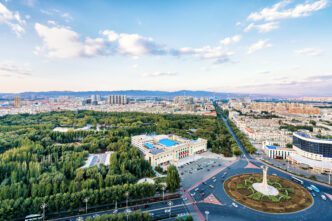In a significant development, the Syrian army has retreated from key southern regions, including Daraa and Sweida, as they urgently redirect forces to defend Homs against advancing insurgents.
The repositioning of Syrian forces marks a notable move in the ongoing conflict, leaving two provincial capitals under opposition control. As insurgents close in on Homs, the third largest city in Syria, the military’s strategic adjustments reflect the increasing pressure faced by President Bashar Assad’s regime.
The rapid territorial gains by opposition forces illustrate a dramatic shift in the military landscape, challenging Assad’s grip as international support wavers. Russia, a key ally, is entangled in its own conflict in Ukraine, while Hezbollah has diminished capabilities following prolonged engagements with Israel. Iran’s regional proxies, too, have been weakened by frequent Israeli airstrikes, with reports indicating a withdrawal of some Iranian military advisers from Syria.
The offensive, initiated by the Hayat Tahrir al-Sham (HTS) group, commenced on November 27 and swiftly captured Aleppo and Hama. HTS, linked to al-Qaida, aims to topple Assad according to its leader, Abu Mohammed al-Golani, during an exclusive interview with CNN. This advance positions the rebels to potentially sever the vital connection between Damascus and the coastal regions, complicating Assad’s efforts to maintain control over the nation.
Military sources confirm that the Syrian army is bolstering defenses in Homs, establishing a defensive line to fortify Damascus from threats emerging in the south. The loss of checkpoints to HTS has necessitated this shift, which may impact the government’s ability to maintain supply lines and reinforce strongholds.
The geopolitical aspects continue to evolve as foreign ministers from Iran, Russia, and Turkey convene in Qatar to address the Syrian crisis. Turkish support for the rebels persists, while Qatar’s Sheikh Mohammed bin Abdulrahman Al Thani criticizes Assad for not utilizing previous lulls in fighting to resolve internal issues, highlighting the risks to Syria’s territorial cohesion.
The military realignment underscores the Syrian army’s control over five provincial capitals — Damascus, Homs, Quneitra, Latakia, and Tartus. Notably, Tartus hosts Russia’s sole naval base beyond Soviet borders, and Latakia houses a significant Russian air base, underscoring the international stakes intertwined with local dynamics.
Meanwhile, in a strategic setback to Iran’s influence, the U.S.-backed Syrian Democratic Forces have gained extensive territories in Deir el-Zour, a crucial zone bordering Iraq. The acquisition of key border crossings further isolates the Syrian government, reducing its external access primarily to the Masnaa crossing with Lebanon.
The current shifts on the battlefield signal a turning point in Syria’s prolonged conflict. As opposition forces consolidate their gains and foreign powers deliberate their roles, the Syrian regime faces critical challenges in maintaining sovereignty and stability.
Source: News4jax








